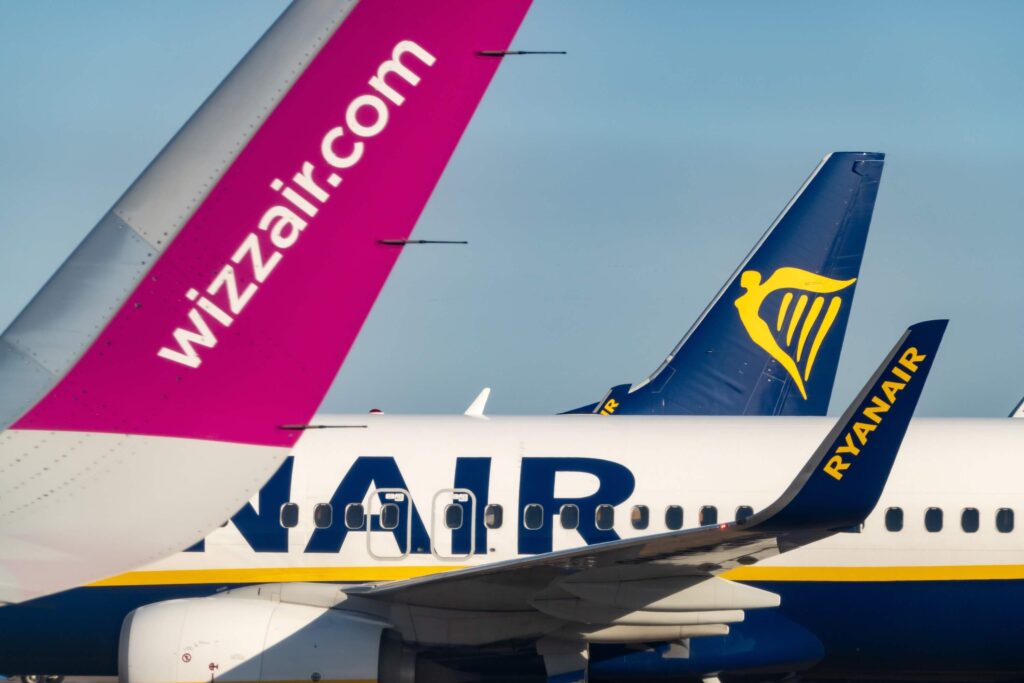Air transport liberalization in Europe has laid the foundation for the low-cost carrier (LCC) market in the region.
The low-cost concept in Europe originated in Ireland and the United Kingdom with the introduction of Ryanair in 1986 and easyJet in 1988. Since the 1990s, Europe has been home to some of the world’s best known LCCs.
Airbus and Boeing, the world’s largest manufacturers, have been fierce competitors in the European LCC market since the inception of the low-cost business model, with the plane makers striving to win the largest market share in the European skies.
But what do the fleets of European budget airlines look like today? Which LCC boasts the most aircraft? And which aircraft manufacturer is leading the way in the European LCC market? AeroTime examines the data.
As of July 2022, there were 40 low-cost airlines registered in the European continent, the International Air Transport Association (IATA) told AeroTime in an emailed statement.
In the following charts, 38 European low-cost carriers are compared by their total fleet size. However, it is worth noting that all charts have excluded LCCs based in Russia, namely Pobeda Airlines and Redwings Airlines, due to data inaccuracy.
In order to determine the size of the aircraft fleet and manufacturer share, AeroTime used data sent by real-time flight tracking company RadarBox, IATA, and the civil aircraft database Planespotters.net. We also checked against the latest developments which have appeared in the news and public announcements made by the airlines.
Ryanair Group – Europe’s largest budget carrier by fleet size
* The subsidiaries of independent low-cost carrier groups such as Ryanair Group, easyJet Group, Wizz Air Group, Corendon Airlines Group were not indicated separately in the chart. The number of aircraft of Transavia France and Transavia Netherlands is combined and can be found by the name ‘Transavia (France, Netherlands)’.
The fleet size of all European low-cost carriers totals 1773 aircraft as of July 2022.
According to the chart, the top five largest LCCs by fleet size include Ireland-based Ryanair Group (Ryanair, Ryanair Sun, Ryanair UK, Malta Air, Buzz, Lauda Europe, Lauda Motion), UK-based easyJet Group (easyJet, easyJet Europe, easyJet Switzerland), Hungary’s Wizz Air Group (Wizz Air, Wizz Air Abu Dhabi, Wizz Air Bulgaria, Wizz Air Ukraine, Wizz Air Malta, Wizz Air UK), Spain’s Vueling and UK’s Jet2.com, respectively.
The combined fleet size of Europe’s five largest airlines totals 1221 aircraft, comprising 646 Airbus planes and 575 Boeing aircraft.
Data from the ‘Fleet composition by aircraft manufacturer’ graph below shows that Airbus is a leader among the top five European LCCs by fleet size, despite Ryanair Group operating 483 Boeing aircraft alone. Even Ryanair Group has a small number of Airbus planes, although it is known to operate a uniform fleet. The carrier’s subsidiary Lauda Europe operates 29 Airbus A320s.
The remaining LCCs, which can be found in the chart below, have a combined fleet of 552 airplanes, comprising 284 Boeing and 263 Airbus, three Embraer and two ATR aircraft.
Additionally, of the top five largest LCCs, Wizz Air Group has the youngest aircraft fleet with an average age of 4.9 years old. This compares to an average fleet age of 8.8 years old at Vueling, 9.1 years old at Ryanair Group and easyJet, and 15.1 years old at Jet2.com.
Airbus – a leader in the European LCC market
The pie chart below shows the manufacturer share in European budget airlines fleets.
Airbus is a dominant plane maker in the region, with a 51.3% market share in the LCC market. This compares to Boeing’s market share of 48.5%.
European LCCs operate a total of 909 Airbus aircraft and 859 Boeing planes. While 99% of European LCC airlines tend to select either European or American plane makers for their fleet, just one budget carrier – Air Europa Express – operates a fleet of three Embraer and two ATR aircraft.
Embraer has just 0.17% of the market share, while ATR has 0.11%.

